Abstract
The hormonal profile of 40 transsexual inmates from a pool of 86 inmates in the California State prison system was studied before and after therapy with feminizing hormones. Clinical and social data were obtained on all 86 inmates; the incidence of human immunodeficiency virus (HIV) seropositivity was examined in 76 of the 86 individuals. Despite similar degrees of feminization in all 40 individuals in whom hormonal studies were performed, variable suppression of serum testosterone concentrations was present. Based on their testosterone concentrations while on feminizing hormone therapy, the transsexual inmates could be divided into three groups. In Group I (the "suppressed" group), the serum testosterone concentrations were markedly depressed (less than 10 ng/dL); in Group II (the "non-suppressed" group), the values of testosterone were normal (446 to 1072 ng/dL); and in Group III (the "intermediate" group), the testosterone values were between those of the suppressed group and the nonsuppressed group. We speculate that feminizing hormone therapy may induce the development of a state of target hormone resistance to testosterone that results in similar degrees of feminization independent of the circulating concentrations of testosterone. The incidence of HIV seropositivity (3/76) was considerably less than anticipated based on previous studies in populations at high risk for developing the acquired immunodeficiency syndrome.
Full text
PDF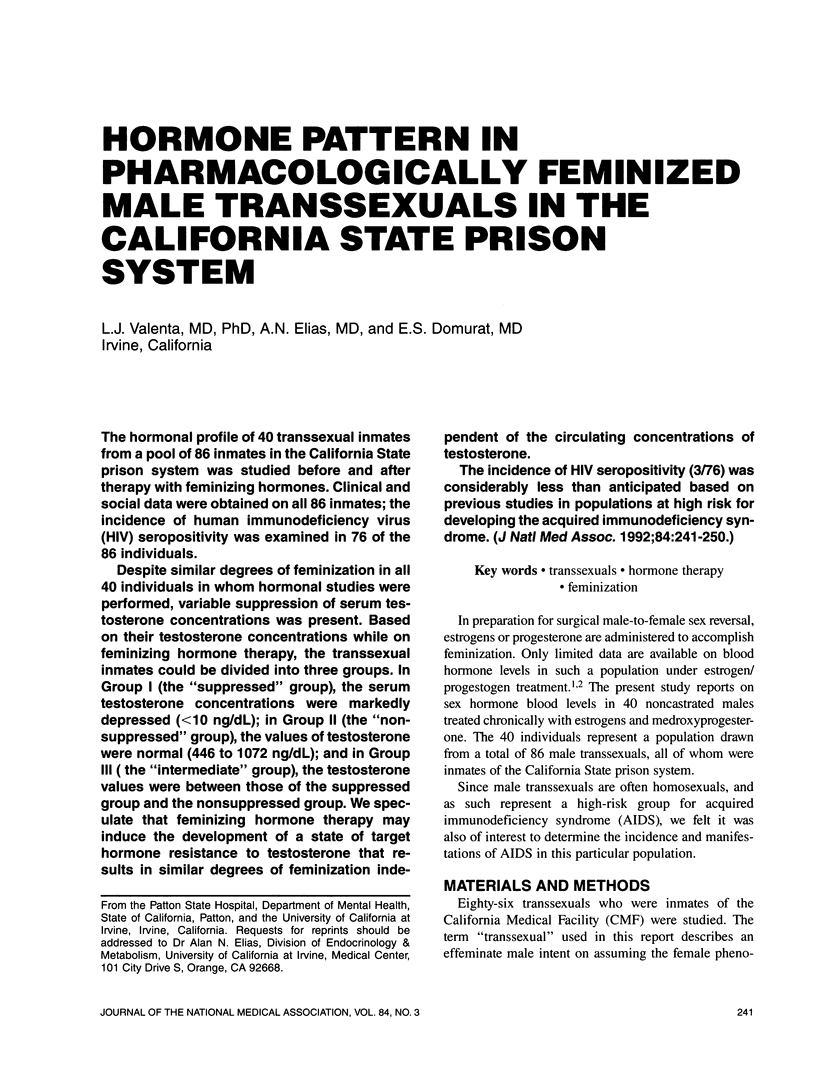


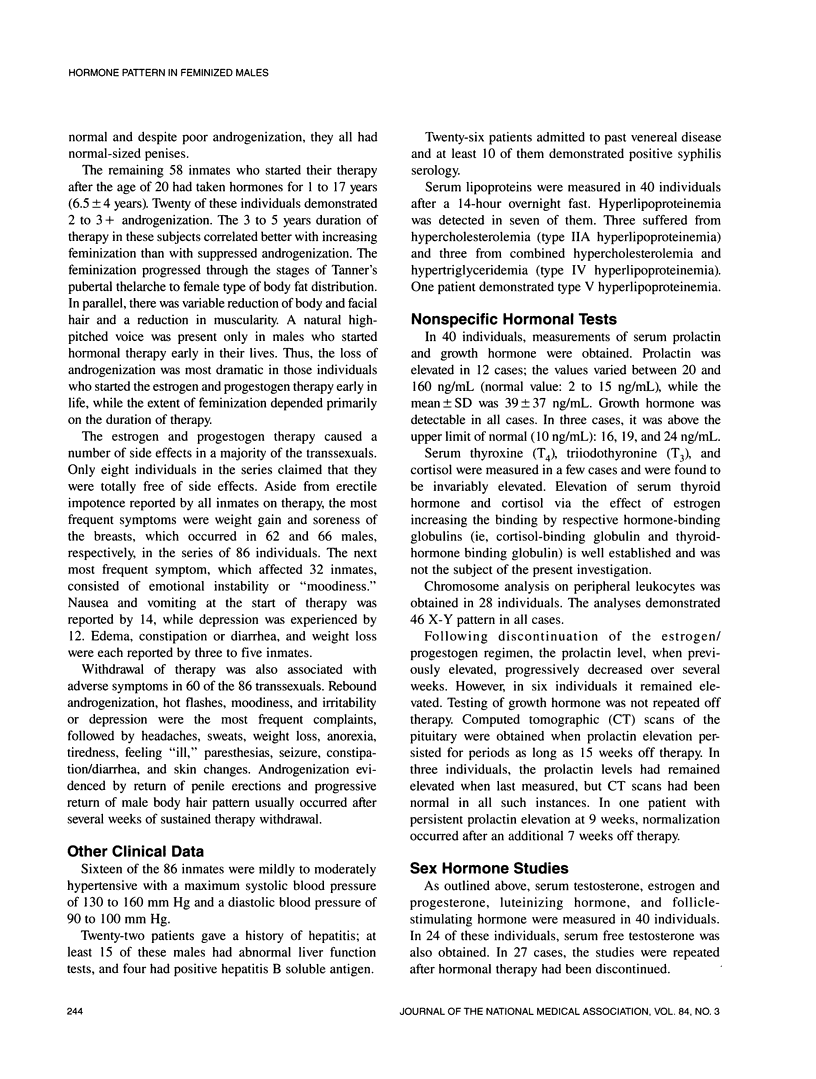
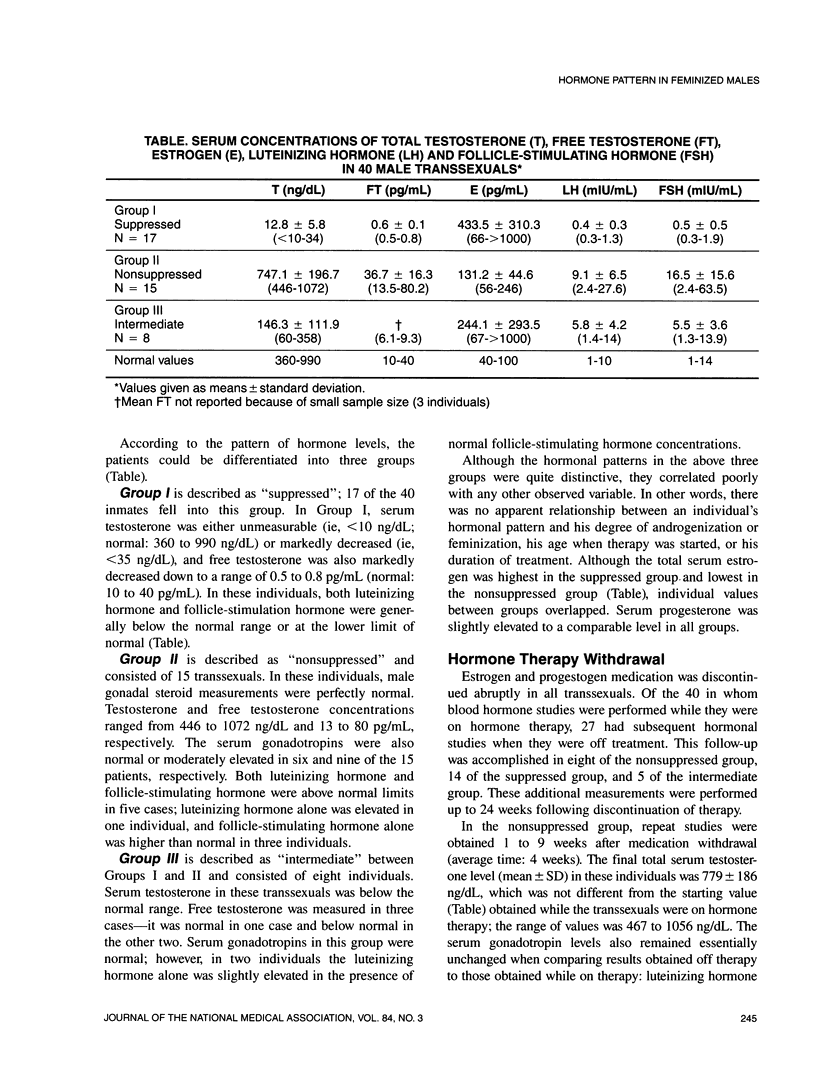
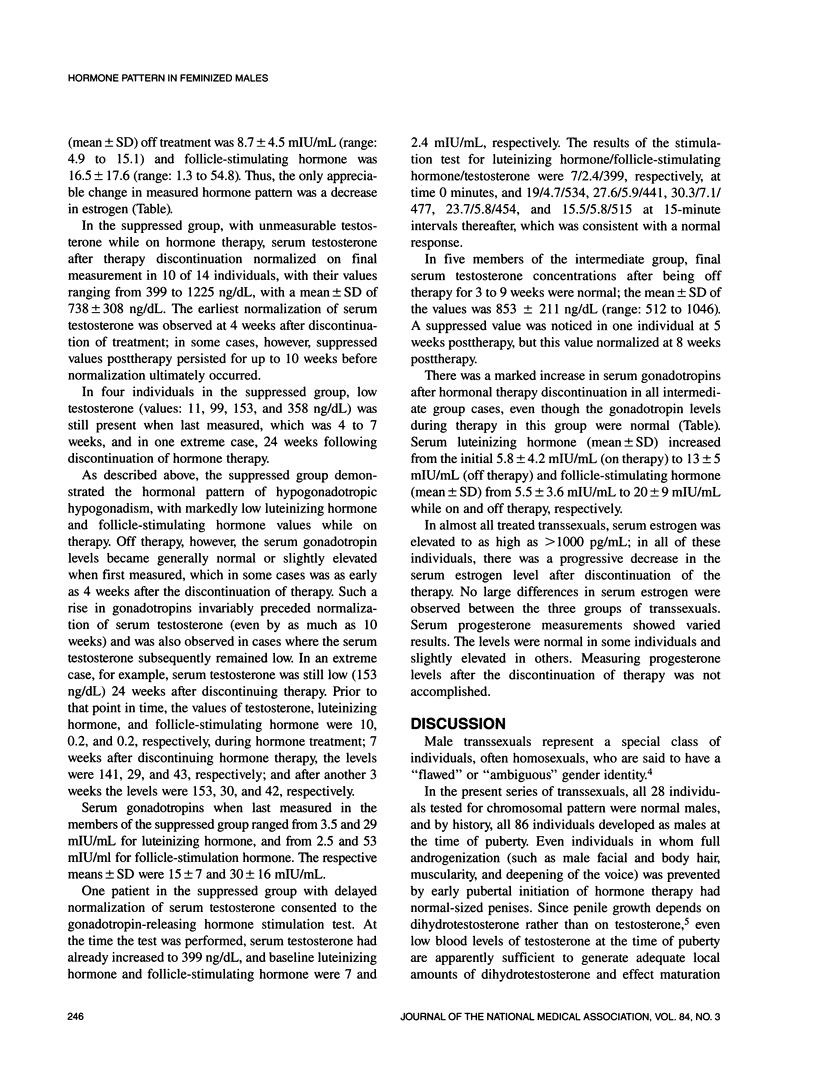

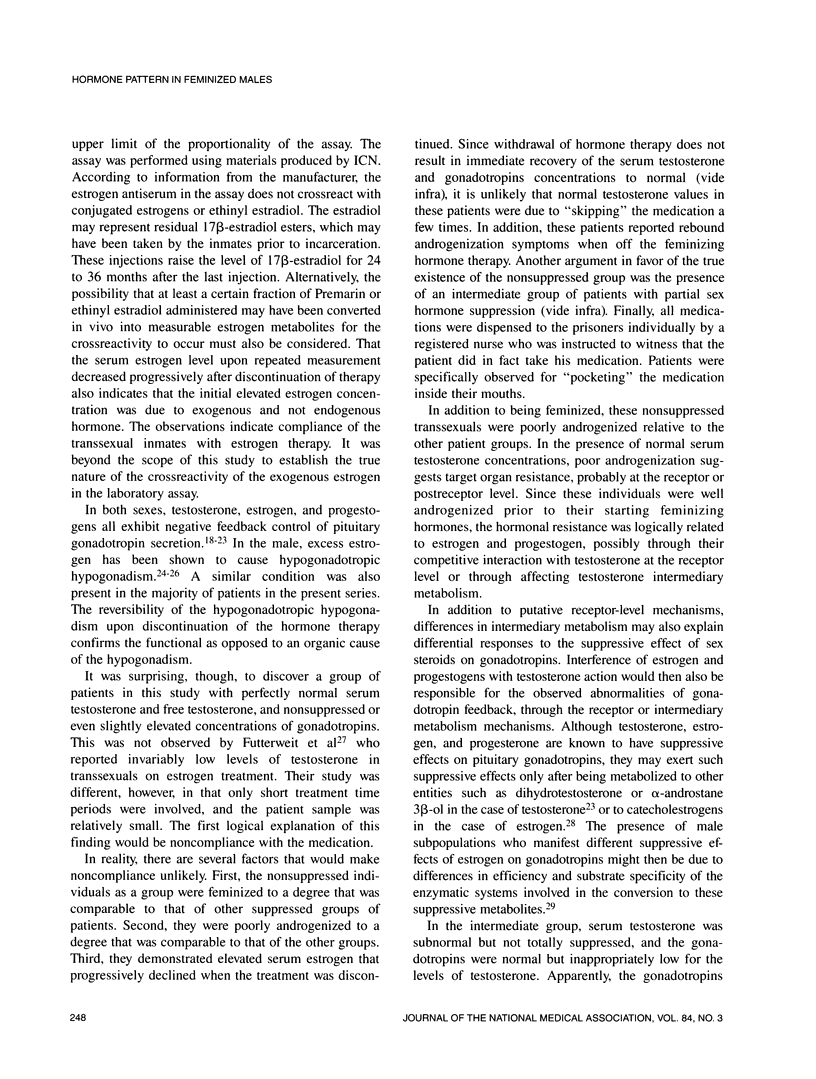
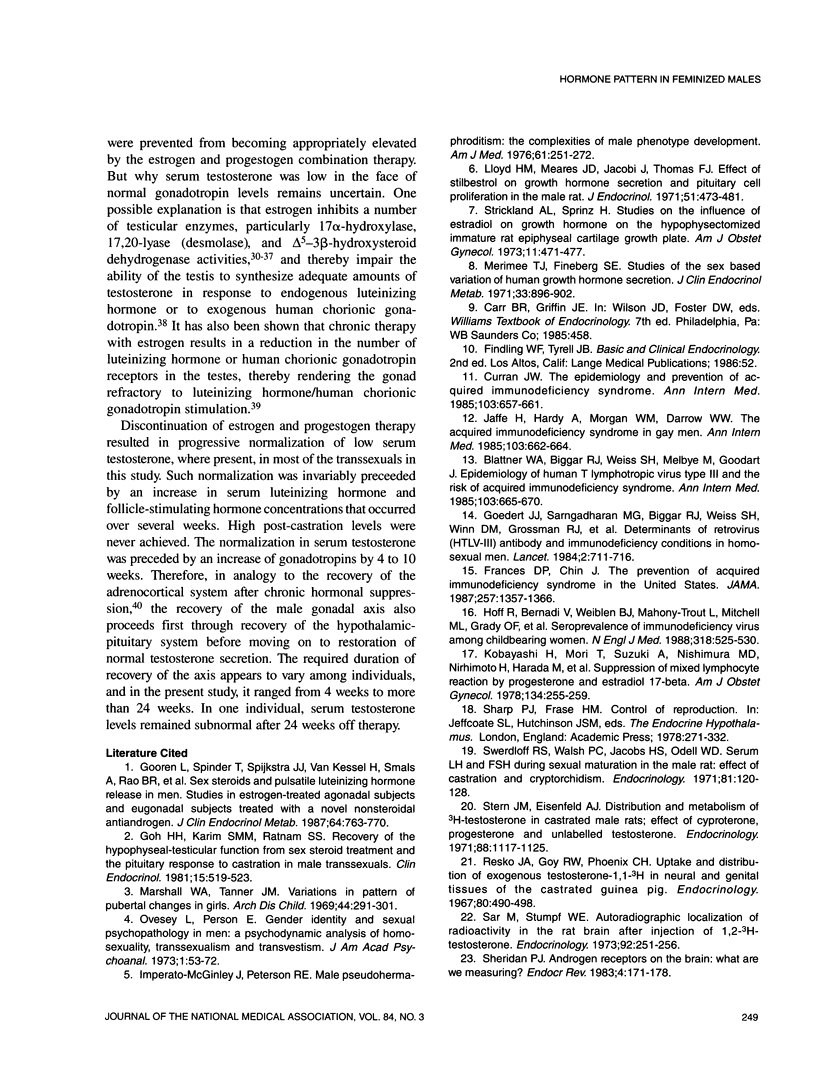

Selected References
These references are in PubMed. This may not be the complete list of references from this article.
- Blattner W. A., Biggar R. J., Weiss S. H., Melbye M., Goedert J. J. Epidemiology of human T-lymphotropic virus type III and the risk of the acquired immunodeficiency syndrome. Ann Intern Med. 1985 Nov;103(5):665–670. doi: 10.7326/0003-4819-103-5-665. [DOI] [PubMed] [Google Scholar]
- Curran J. W. The epidemiology and prevention of the acquired immunodeficiency syndrome. Ann Intern Med. 1985 Nov;103(5):657–662. doi: 10.7326/0003-4819-103-5-657. [DOI] [PubMed] [Google Scholar]
- Fan D. F., Troen P. Studies of the human testis. VII. Conversion of pregnenolone to progesterone. J Clin Endocrinol Metab. 1975 Sep;41(3):563–574. doi: 10.1210/jcem-41-3-563. [DOI] [PubMed] [Google Scholar]
- Francis D. P., Chin J. The prevention of acquired immunodeficiency syndrome in the United States. An objective strategy for medicine, public health, business, and the community. JAMA. 1987 Mar 13;257(10):1357–1366. [PubMed] [Google Scholar]
- GRABER A. L., NEY R. L., NICHOLSON W. E., ISLAND D. P., LIDDLE G. W. NATURAL HISTORY OF PITUITARY-ADRENAL RECOVERY FOLLOWING LONG-TERM SUPPRESSION WITH CORTICOSTEROIDS. J Clin Endocrinol Metab. 1965 Jan;25:11–16. doi: 10.1210/jcem-25-1-11. [DOI] [PubMed] [Google Scholar]
- Goedert J. J., Sarngadharan M. G., Biggar R. J., Weiss S. H., Winn D. M., Grossman R. J., Greene M. H., Bodner A. J., Mann D. L., Strong D. M. Determinants of retrovirus (HTLV-III) antibody and immunodeficiency conditions in homosexual men. Lancet. 1984 Sep 29;2(8405):711–716. doi: 10.1016/s0140-6736(84)92624-2. [DOI] [PubMed] [Google Scholar]
- Goh H. H., Karim S. M., Ratnam S. S. Recovery of hypophyseal-testicular function from sex steroid treatment and the pituitary response to castration in male transsexuals. Clin Endocrinol (Oxf) 1981 Nov;15(5):519–523. doi: 10.1111/j.1365-2265.1981.tb00696.x. [DOI] [PubMed] [Google Scholar]
- Gooren L., Spinder T., Spijkstra J. J., van Kessel H., Smals A., Rao B. R., Hoogslag M. Sex steroids and pulsatile luteinizing hormone release in men. Studies in estrogen-treated agonadal subjects and eugonadal subjects treated with a novel nonsteroidal antiandrogen. J Clin Endocrinol Metab. 1987 Apr;64(4):763–770. doi: 10.1210/jcem-64-4-763. [DOI] [PubMed] [Google Scholar]
- Hoff R., Berardi V. P., Weiblen B. J., Mahoney-Trout L., Mitchell M. L., Grady G. F. Seroprevalence of human immunodeficiency virus among childbearing women. Estimation by testing samples of blood from newborns. N Engl J Med. 1988 Mar 3;318(9):525–530. doi: 10.1056/NEJM198803033180901. [DOI] [PubMed] [Google Scholar]
- Imperato-McGinley J., Peterson R. E. Male pseudohermaphroditism: the complexities of male phenotypic development. Am J Med. 1976 Aug;61(2):251–272. doi: 10.1016/0002-9343(76)90175-3. [DOI] [PubMed] [Google Scholar]
- Jaffe H. W., Hardy A. M., Morgan W. M., Darrow W. W. The acquired immunodeficiency syndrome in gay men. Ann Intern Med. 1985 Nov;103(5):662–664. doi: 10.7326/0003-4819-103-5-662. [DOI] [PubMed] [Google Scholar]
- Jones T. M., Fang V. S., Landau R. L., Rosenfield R. Direct inhibition of Leydig cell function by estradiol. J Clin Endocrinol Metab. 1978 Dec;47(6):1368–1373. doi: 10.1210/jcem-47-6-1368. [DOI] [PubMed] [Google Scholar]
- Kalla N. R., Nisula B. C., Menard R., Loriaux D. L. The effect of estradiol on testicular testosterone biosynthesis. Endocrinology. 1980 Jan;106(1):35–39. doi: 10.1210/endo-106-1-35. [DOI] [PubMed] [Google Scholar]
- Kalla N. R., Nisula B. C., Menard R., Loriaux D. L. The effect of estradiol on testicular testosterone biosynthesis. Endocrinology. 1980 Jan;106(1):35–39. doi: 10.1210/endo-106-1-35. [DOI] [PubMed] [Google Scholar]
- Kobayashi H., Mori T., Suzuki A., Nishimura T., Nishimoto H., Harada M. Suppression of mixed lymphocyte reaction by progesterone and estradiol-17beta. Am J Obstet Gynecol. 1979 Jun 1;134(3):255–259. doi: 10.1016/s0002-9378(16)33029-0. [DOI] [PubMed] [Google Scholar]
- Leinonen P., Ruokonen A., Kontturi M., Vihko R. Effects of estrogen treatment on human testicular unconjugated steroid and steroid sulfate production in vivo. J Clin Endocrinol Metab. 1981 Sep;53(3):569–573. doi: 10.1210/jcem-53-3-569. [DOI] [PubMed] [Google Scholar]
- Lieberburg I., Maclusky N. J., McEwen B. S. 5alpha-Dihydrotestosterone (DHT) receptors in rat brain and pituitary cell nuclei. Endocrinology. 1977 Feb;100(2):598–607. doi: 10.1210/endo-100-2-598. [DOI] [PubMed] [Google Scholar]
- Lloyd H. M., Meares J. D., Jacobi J., Thomas F. J. Effects of stilboestrol on growth hormone secretion and pituitary cell proliferation in the male rat. J Endocrinol. 1971 Nov;51(3):473–481. doi: 10.1677/joe.0.0510473. [DOI] [PubMed] [Google Scholar]
- Marshall W. A., Tanner J. M. Variations in pattern of pubertal changes in girls. Arch Dis Child. 1969 Jun;44(235):291–303. doi: 10.1136/adc.44.235.291. [DOI] [PMC free article] [PubMed] [Google Scholar]
- Merimee T. J., Fineberg S. E. Studies of the sex based variation of human growth hormone secretion. J Clin Endocrinol Metab. 1971 Dec;33(6):896–902. doi: 10.1210/jcem-33-6-896. [DOI] [PubMed] [Google Scholar]
- Oshima H., Sarada T., Ochiai K., Tamaoki B. Effects of a synthetic estrogen upon steroid bioconversion in vitro in testes of patients with prostatic cancer. Invest Urol. 1974 Jul;12(1):43–49. [PubMed] [Google Scholar]
- Payne A. H., Jaffe R. B., Abell M. R. Gonadal steroid sulfates and sulfatase. 3. Correlation of human testicular sulfatase, 3beta-hydroxysteroid dehydrogenase-isomerase, histologic structure and serum testosterone. J Clin Endocrinol Metab. 1971 Oct;33(4):582–591. doi: 10.1210/jcem-33-4-582. [DOI] [PubMed] [Google Scholar]
- Saez J. M., Haour F., Loras B., Sanchez P., Cathiard A. M. Oestrogen induced Leydig cell refractoriness to gonadotrophin stimulation. Acta Endocrinol (Copenh) 1978 Oct;89(2):379–392. doi: 10.1530/acta.0.0890379. [DOI] [PubMed] [Google Scholar]
- Sar M., Stumpf W. E. Autoradiographic localization of radioactivity in the rat brain after the injection of 1,2-3H-testosterone. Endocrinology. 1973 Jan;92(1):251–256. doi: 10.1210/endo-92-1-251. [DOI] [PubMed] [Google Scholar]
- Sheridan P. J. Androgen receptors in the brain: what are we measuring? Endocr Rev. 1983 Spring;4(2):171–178. doi: 10.1210/edrv-4-2-171. [DOI] [PubMed] [Google Scholar]
- Stern J. M., Eisenfeld A. J. Distribution and metabolism of 3H-testosterone in castrated male rats; effects of cyproterone, progesterone and unlabeled testosterone. Endocrinology. 1971 May;88(5):1117–1125. doi: 10.1210/endo-88-5-1117. [DOI] [PubMed] [Google Scholar]
- Strickland A. L., Sprinz H. Studies of the influence of estradiol and growth hormone on the hypophysectomized immature rat epiphyseal cartilage growth plate. Am J Obstet Gynecol. 1973 Feb 15;115(4):471–477. doi: 10.1016/0002-9378(73)90393-1. [DOI] [PubMed] [Google Scholar]
- Swerdloff R. S., Walsh P. C., Jacobs H. S., Odell W. D. Serum LH and FSH during sexual maturation in the male rat: effect of castration and cryptorchidism. Endocrinology. 1971 Jan;88(1):120–128. doi: 10.1210/endo-88-1-120. [DOI] [PubMed] [Google Scholar]
- Valenta L. J. A syndrome of functional hypogonadotropic hypogonadism and sterility in a male with elevated serum estradiol. Fertil Steril. 1977 Aug;28(8):881–884. [PubMed] [Google Scholar]
- Veldhuis J. D., Sowers J. R., Rogol A. D., Klein F. A., Miller N., Dufau M. L. Pathophysiology of male hypogonadism associated with endogenous hyperestrogenism. Evidence for dual defects in the gonadal axis. N Engl J Med. 1985 May 23;312(21):1371–1375. doi: 10.1056/NEJM198505233122107. [DOI] [PubMed] [Google Scholar]
- Yanaihara T., Troen P., Troen B. R., Troen M. L. Studies of the human testis. 3. Effect of estrogen on testosterone formation in human testis in vitro. J Clin Endocrinol Metab. 1972 Jun;34(6):968–973. doi: 10.1210/jcem-34-6-968. [DOI] [PubMed] [Google Scholar]


